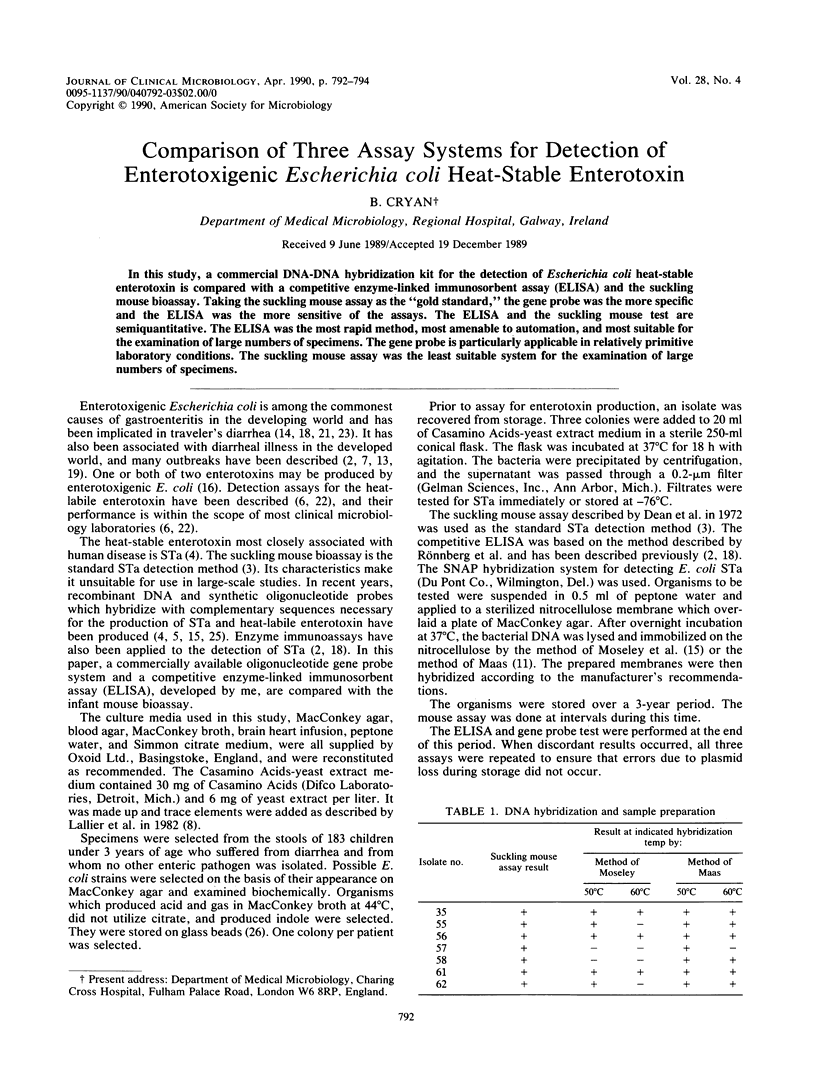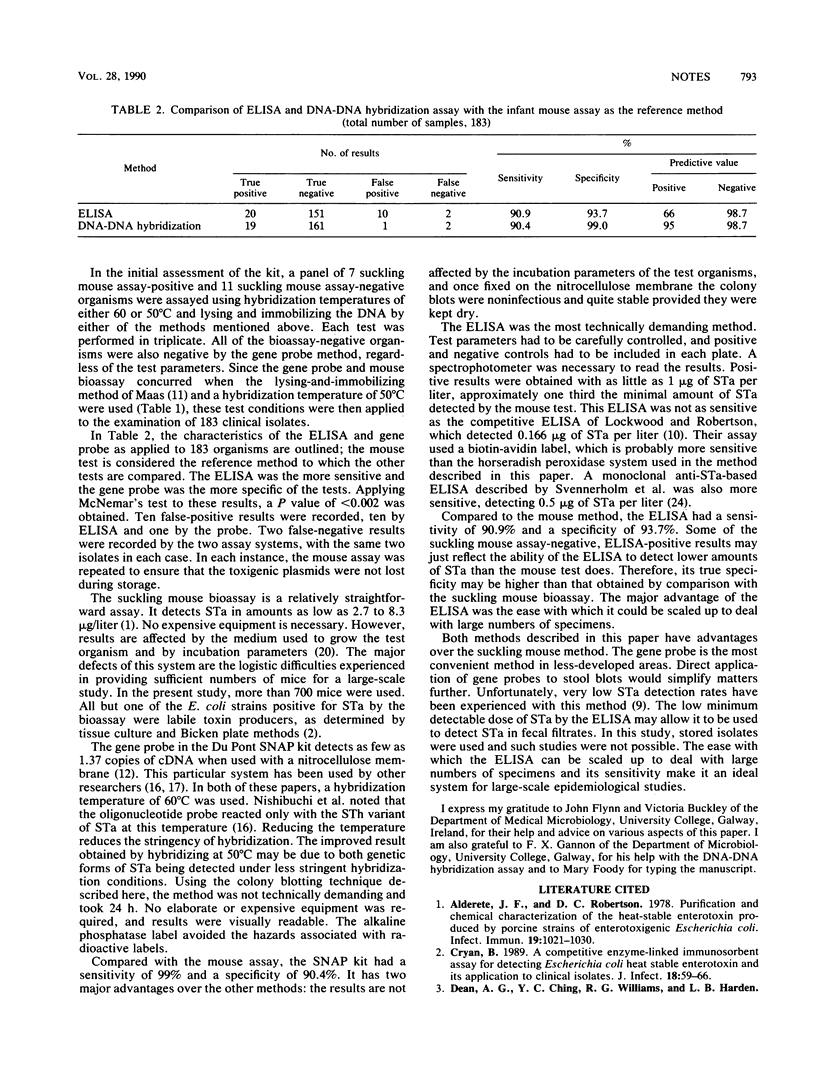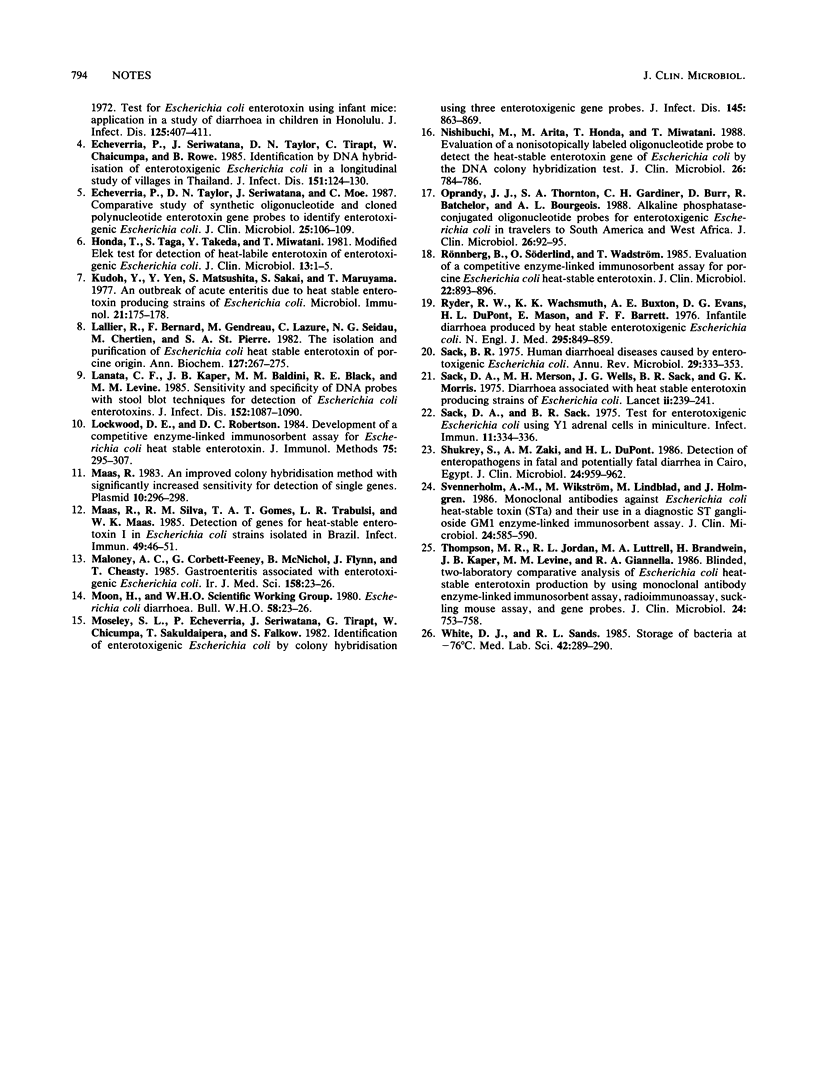Abstract
In this study, a commercial DNA-DNA hybridization kit for the detection of Escherichia coli heat-stable enterotoxin is compared with a competitive enzyme-linked immunosorbent assay (ELISA) and the suckling mouse bioassay. Taking the suckling mouse assay as the "gold standard," the gene probe was the more specific and the ELISA was the more sensitive of the assays. The ELISA and the suckling mouse test are semiquantitative. The ELISA was the most rapid method, most amenable to automation, and most suitable for the examination of large numbers of specimens. The gene probe is particularly applicable in relatively primitive laboratory conditions. The suckling mouse assay was the least suitable system for the examination of large numbers of specimens.
Full text
PDF


Selected References
These references are in PubMed. This may not be the complete list of references from this article.
- Alderete J. F., Robertson D. C. Purification and chemical characterization of the heat-stable enterotoxin produced by porcine strains of enterotoxigenic Escherichia coli. Infect Immun. 1978 Mar;19(3):1021–1030. doi: 10.1128/iai.19.3.1021-1030.1978. [DOI] [PMC free article] [PubMed] [Google Scholar]
- Cryan B. A competitive enzyme-linked immunosorbent assay for detecting Escherichia coli heat-stable enterotoxin and its application to clinical isolates. J Infect. 1989 Jan;18(1):59–66. doi: 10.1016/s0163-4453(89)93692-x. [DOI] [PubMed] [Google Scholar]
- Echeverria P., Seriwatana J., Taylor D. N., Tirapat C., Chaicumpa W., Rowe B. Identification by DNA hybridization of enterotoxigenic Escherichia coli in a longitudinal study of villages in Thailand. J Infect Dis. 1985 Jan;151(1):124–130. doi: 10.1093/infdis/151.1.124. [DOI] [PubMed] [Google Scholar]
- Echeverria P., Taylor D. N., Seriwatana J., Moe C. Comparative study of synthetic oligonucleotide and cloned polynucleotide enterotoxin gene probes to identify enterotoxigenic Escherichia coli. J Clin Microbiol. 1987 Jan;25(1):106–109. doi: 10.1128/jcm.25.1.106-109.1987. [DOI] [PMC free article] [PubMed] [Google Scholar]
- Honda T., Taga S., Takeda Y., Miwatani T. Modified Elek test for detection of heat-labile enterotoxin of enterotoxigenic Escherichia coli. J Clin Microbiol. 1981 Jan;13(1):1–5. doi: 10.1128/jcm.13.1.1-5.1981. [DOI] [PMC free article] [PubMed] [Google Scholar]
- Kudoh Y., Zen-Yoji H., Matsushita S., Sakai S., Maruyama T. Outbreaks of acute enteritis due to heat-stable enterotoxin-producing strains of Escherichia coli. Microbiol Immunol. 1977;21(3):175–178. doi: 10.1111/j.1348-0421.1977.tb00278.x. [DOI] [PubMed] [Google Scholar]
- Lallier R., Bernard F., Gendreau M., Lazure C., Seidah N. G., Chrétien M., St-Pierre S. A. Isolation and purification of Escherichia coli heat-stable enterotoxin of porcine origin. Anal Biochem. 1982 Dec;127(2):267–275. doi: 10.1016/0003-2697(82)90171-3. [DOI] [PubMed] [Google Scholar]
- Lanata C. F., Kaper J. B., Baldini M. M., Black R. E., Levine M. M. Sensitivity and specificity of DNA probes with the stool blot technique for detection of Escherichia coli enterotoxins. J Infect Dis. 1985 Nov;152(5):1087–1090. doi: 10.1093/infdis/152.5.1087. [DOI] [PubMed] [Google Scholar]
- Lockwood D. E., Robertson D. C. Development of a competitive enzyme-linked immunosorbent assay (ELISA) for Escherichia coli heat-stable enterotoxin (STa). J Immunol Methods. 1984 Dec 31;75(2):295–307. doi: 10.1016/0022-1759(84)90113-3. [DOI] [PubMed] [Google Scholar]
- Maas R. An improved colony hybridization method with significantly increased sensitivity for detection of single genes. Plasmid. 1983 Nov;10(3):296–298. doi: 10.1016/0147-619x(83)90045-8. [DOI] [PubMed] [Google Scholar]
- Maas R., Silva R. M., Gomes T. A., Trabulsi L. R., Maas W. K. Detection of genes for heat-stable enterotoxin I in Escherichia coli strains isolated in Brazil. Infect Immun. 1985 Jul;49(1):46–51. doi: 10.1128/iai.49.1.46-51.1985. [DOI] [PMC free article] [PubMed] [Google Scholar]
- Moloney A. C., Corbett-Feeney G., McNicholl B., Flynn J., Cheasty T. Gastroenteritis associated with enterotoxigenic Escherichia coli 078 H12. Ir J Med Sci. 1985 Jan;154(1):23–26. doi: 10.1007/BF02937034. [DOI] [PubMed] [Google Scholar]
- Moseley S. L., Echeverria P., Seriwatana J., Tirapat C., Chaicumpa W., Sakuldaipeara T., Falkow S. Identification of enterotoxigenic Escherichia coli by colony hybridization using three enterotoxin gene probes. J Infect Dis. 1982 Jun;145(6):863–869. doi: 10.1093/infdis/145.6.863. [DOI] [PubMed] [Google Scholar]
- Nishibuchi M., Arita M., Honda T., Miwatani T. Evaluation of a nonisotopically labeled oligonucleotide probe to detect the heat-stable enterotoxin gene of Escherichia coli by the DNA colony hybridization test. J Clin Microbiol. 1988 Apr;26(4):784–786. doi: 10.1128/jcm.26.4.784-786.1988. [DOI] [PMC free article] [PubMed] [Google Scholar]
- Oprandy J. J., Thornton S. A., Gardiner C. H., Burr D., Batchelor R., Bourgeois A. L. Alkaline phosphatase-conjugated oligonucleotide probes for enterotoxigenic Escherichia coli in travelers to South America and West Africa. J Clin Microbiol. 1988 Jan;26(1):92–95. doi: 10.1128/jcm.26.1.92-95.1988. [DOI] [PMC free article] [PubMed] [Google Scholar]
- Ryder R. W., Wachsmuth I. K., Buxton A. E., Evans D. G., DuPont H. L., Mason E., Barrett F. F. Infantile diarrhea produced by heat-stable enterotoxigenic Escherichia coli. N Engl J Med. 1976 Oct 14;295(16):849–853. doi: 10.1056/NEJM197610142951601. [DOI] [PubMed] [Google Scholar]
- Rönnberg B., Söderlind O., Wadström T. Evaluation of a competitive enzyme-linked immunosorbent assay for porcine Escherichia coli heat-stable enterotoxin. J Clin Microbiol. 1985 Dec;22(6):893–896. doi: 10.1128/jcm.22.6.893-896.1985. [DOI] [PMC free article] [PubMed] [Google Scholar]
- Sack D. A., Merson M. H., Wells J. G., Sack R. B., Morris G. K. Diarrhoea associated with heat-stable enterotoxin-producing strains of Escherichia coli. Lancet. 1975 Aug 9;2(7928):239–241. doi: 10.1016/s0140-6736(75)90958-7. [DOI] [PubMed] [Google Scholar]
- Sack D. A., Sack R. B. Test for enterotoxigenic Escherichia coli using Y-1 adrenal cells in miniculture. Infect Immun. 1975 Feb;11(2):334–336. doi: 10.1128/iai.11.2.334-336.1975. [DOI] [PMC free article] [PubMed] [Google Scholar]
- Sack R. B. Human diarrheal disease caused by enterotoxigenic Escherichia coli. Annu Rev Microbiol. 1975;29:333–353. doi: 10.1146/annurev.mi.29.100175.002001. [DOI] [PubMed] [Google Scholar]
- Shukry S., Zaki A. M., DuPont H. L., Shoukry I., el Tagi M., Hamed Z. Detection of enteropathogens in fatal and potentially fatal diarrhea in Cairo, Egypt. J Clin Microbiol. 1986 Dec;24(6):959–962. doi: 10.1128/jcm.24.6.959-962.1986. [DOI] [PMC free article] [PubMed] [Google Scholar]
- Svennerholm A. M., Wikström M., Lindblad M., Holmgren J. Monoclonal antibodies against Escherichia coli heat-stable toxin (STa) and their use in a diagnostic ST ganglioside GM1-enzyme-linked immunosorbent assay. J Clin Microbiol. 1986 Oct;24(4):585–590. doi: 10.1128/jcm.24.4.585-590.1986. [DOI] [PMC free article] [PubMed] [Google Scholar]
- Thompson M. R., Jordan R. L., Luttrell M. A., Brandwein H., Kaper J. B., Levine M. M., Giannella R. A. Blinded, two-laboratory comparative analysis of Escherichia coli heat-stable enterotoxin production by using monoclonal antibody enzyme-linked immunosorbent assay, radioimmunoassay, suckling mouse assay, and gene probes. J Clin Microbiol. 1986 Nov;24(5):753–758. doi: 10.1128/jcm.24.5.753-758.1986. [DOI] [PMC free article] [PubMed] [Google Scholar]
- White D. J., Sands R. L. Storage of bacteria at -76 degrees C. Med Lab Sci. 1985 Jul;42(3):289–290. [PubMed] [Google Scholar]


